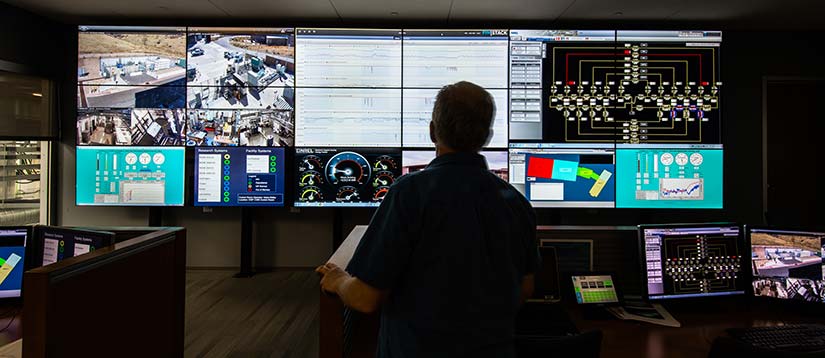Renewable Energy Generation and Storage Models
Renewable energy generation and storage models enable researchers to study the impact of integrating large-scale renewable energy resources into the electric power grid.

Renewable generation differs from traditional generation in many ways. A renewable power plant consists of hundreds of small renewable energy generators (of 1–5 MW) with power electronics that interface with the grid, while a conventional power plant consists of one or two large synchronous generators (of 50–500 MW) that connect directly to the grid. In addition, the variability of renewable energy resources and the reduction in system inertia associated with renewable generators require unique, flexible controls and energy storage for optimum integration.
NLR researchers develop models of renewable energy generators, storage, and renewable power plants to enable:
System planners to perform system impact studies
Renewable energy generation manufacturers to improve control algorithms, efficiency, and reliability
Renewable power plant owners, operators, and developers to optimize their interface with the grid
Independent system operators to improve the stability of the grid by simulating remedial action schemes to stabilize their balancing area or larger power system.
Capabilities
Development of dynamic models of tidal and river generators, adjustable-speed pumped storage hydro, wind turbine generators, wind plants, energy storage, photovoltaic (PV) inverters, and PV plants
Development of transient models of PV generators and storage with power electronics converters
Development of PV inverter control algorithms and validation through simulation
Development of algorithms of inertial response from wind power plants
Oscillation damping with renewable energy generators and renewable power plants for sub-synchronous resonance, interarea-oscillation, and other events
Development of real-time models of renewable generators (PV, wind, storage) and conventional generators (synchronous machines) in RTDS and Opal-RT platforms for hardware-in-the-loop testing
Projects
NLR engineers have worked with the utility and renewable energy industries to develop dynamic models of renewable generators and renewable power plants with positive sequence power system simulators and electromagnetic transient simulators to allow large-scale system impact studies, utility grid integration, the development of new control algorithms, and ancillary service provisions from renewable sources.
NLR's research and engineering staff supports the development of guidelines, recommended practices, and standards in collaboration with the Institute of Electrical and Electronics Engineers, Western Electricity Coordinating Council, the International Energy Agency, and the International Electrotechnical Commission in the areas of dynamic modeling of wind turbine generators and wind power plants.
NLR researchers are developing software-and-hardware-combined simulation testing methods known as power hardware-in-the-loop testing.
Power hardware in the loop allows real-time models of power system networks in RTDS and Opal-RT to be integrated with actual hardware under test (such as wind turbines, PV inverters, and storage) to simulate real-world events such as interarea oscillations, subsynchronous resonance, and faults and disturbances. Power-hardware-in-the-loop methodology provides unique capabilities to investigate the impact of renewable plants on transmission and distribution power systems, determine their interactions, develop mitigation strategies, and validate real hardware at power before it is installed in the field.
NLR researchers worked with Xcel Energy and NGK to develop a dynamic model of a 1-MW, 7.2-MWh sodium sulfur energy storage battery in Luverne, Minnesota. The model was developed to help Xcel Energy understand and validate energy storage in various modes of operation, such as time-shifting, economic dispatch, frequency regulation, wind smoothing, and wind levelling.
Publications
Dynamic Modeling of Adjustable-Speed Pumped Storage Hydropower Plant, IEEE Power and Energy Society General Meeting (2015)
Modeling and Control of Type-2 Wind Turbines for Sub-Synchronous Resonance Damping, Energy Conversion and Management (2015)
Synchrophasor-Based Auxiliary Controller to Enhance the Voltage Stability of a Distribution System With High Renewable Energy Penetration, IEEE Transactions on Smart Grid (2015)
Gearbox and Drivetrain Models To Study Dynamic Effects of Modern Wind Turbines, IEEE Transactions on Industry Applications (2014)
Impacts of Providing Inertial Response on Dynamic Loads of Wind Turbine Drivetrains, IEEE Energy Conversion Congress and Exposition (2014)
Oscillation Damping: A Comparison of Wind and Photovoltaic Power Plant Capabilities, IEEE Symposium Power Electronics and Machines for Wind and Water Applications (2014)
PV Generation Enhancement with a Virtual Inertia Emulator to Provide Inertial Response to the Grid, IEEE Energy Conversion Congress and Exposition (2014)
User Guide for PV Dynamic Model Simulation Written on PSCAD Platform, NLR Technical Report (2014)
Contact
Share
Last Updated Dec. 31, 2025
